Lipid Nanoparticles Loaded with Selected Iridoid Glycosides as Effective Components of Hydrogel Formulations
Abstract
:1. Introduction
2. Materials and Methods
2.1. Materials
2.1.1. Reagents
2.1.2. Skin Testing Equipment
2.1.3. Testing Panel
2.2. Methods
2.2.1. Production of Lipid Nanoparticles
2.2.2. Physicochemical Characterization of Lipid Nanoparticles
2.2.3. Preparation of Hydrogel Formulations
2.2.4. Physicochemical Characterization of Hydrogel Formulations
2.2.5. Determination of AI in the Hydrogel Formulations (HPLC)
2.2.6. Release Study
2.2.7. The Application Tests
3. Results and Discussion
3.1. Characterization of Lipid Nanoparticles
3.2. Physicochemical Characteristics of Hydrogel Formulations
3.2.1. pH Test
3.2.2. Viscosity Study
3.2.3. Particle Size Distribution Analysis
3.3. Evaluation of Chemical Stability of Iridoid Glycosides in the Hydrogel Formulations (HPLC)
3.4. Assessment of the Release Profiles of Iridoid Glycosides in the Hydrogels Formulations
3.5. Skin Parameters Estimation (In Vivo Tests)
3.5.1. Analysis of the Transepidermal Water Loss and the Skin Hydration Measurement
3.5.2. Analysis of the Skin Topography Parameters
- decrease in the values of SELS parameters: (i) SEr (roughness) associated with the number of dark pixels present in the image, reflecting wrinkles and furrows in the skin; (ii) SEsm (smoothness) understood as the homogeneity of the obtained image in terms of the lowest possible variation of grey levels in the images; (iii) SEsc (scaliness) expressed as the number of white pixels in the image, identified as the skin with reduced hydration level [21,23,24];
- increase in NRJ (energy) and HOM (homogeneity) values and decrease in CONT (contrast) values, which are specific indicators of the uniformity and overall condition of the skin surface, calculated by analyzing repetitions of combinations of colors of neighboring pixels in the image and the difference between their levels of grey [21,23].
3.5.3. Analysis of the Skin Macrorelief Parameters
4. Conclusions
Author Contributions
Funding
Institutional Review Board Statement
Informed Consent Statement
Data Availability Statement
Conflicts of Interest
References
- Keck, C.M. Lipid Nanoparticles (SLN, NLC) for Innovative Consumer Care & Household Products. Househ. Person. Care Today 2014, 9, 18–24. [Google Scholar]
- Yadav, N.; Khatak, S.; Singh Sara, U.V. Solid Lipid Nanoparticles—A Review. Int. J. Appl. Pharm. 2013, 5, 8–18. [Google Scholar]
- Müller, R.H.; Radtke, M.; Wissing, S.A. Solid Lipid Nanoparticles (SLN) and Nanostructured Lipid Carriers (NLC) in Cosmetic and Dermatological Preparations. Adv. Drug Deliv. Rev. 2002, 54, 131–155. [Google Scholar] [CrossRef]
- Souto, E.B.; Müller, R.H. Lipid Nanoparticles: Effect on Bioavailability and Pharmacokinetic Changes. In Handbook of Experimental Pharmacology; Springer: Berlin/Heidelberg, Germany, 2010; pp. 115–141. [Google Scholar]
- Souto, E.B.; Müller, R.H. Lipid Nanoparticles (Solid Lipid Nanoparticles and Nanostructured Lipid Carriers) for Cosmetic, Dermal, and Transdermal Applications. In Nanoparticulate Drug Delivery Systems; Thassu, D., Ed.; CRC Press: New York, NY, USA, 2007; pp. 213–233. [Google Scholar]
- Debjit, B.; Chiranjib, M.R. Role of Nanotechnology in Novel Drug Delivery System. Scribd 2009, 1, 20–35. [Google Scholar]
- Świątek-Prokop, J. Nanomateriały: Zalety i Zagrożenia. Pr. Nauk. Akad. Jana Długosza Częs. Eduk. Tech. Inform. 2012, 7, 45–57. [Google Scholar]
- Szlecht, A.; Schroeder, G. Zastosowanie nanotechnologii w kosmetologii. In Nanotechnologia, Kosmetyki, Chemia Supramolekularna; Schroeder, G., Ed.; Cursiva: Warszawa, Poland, 2010; pp. 7–33. [Google Scholar]
- Moskaluk-Grochowicz, A.; Wolniak, R. Ryzyko związane z wykorzystaniem nanocząstek w kosmetykach. Zesz. Naukowe Organ. Zarządzanie Politech. Śląska 2014, 71, 231–242. [Google Scholar]
- Souto, E.B.; Baldim, I.; Oliveira, W.P.; Rao, R.; Yadav, N.; Gama, F.M.; Mahant, S. SLN and NLC for Topical, Dermal, and Transdermal Drug Delivery. Expert Opin. Drug Deliv. 2020, 17, 357–377. [Google Scholar] [CrossRef] [PubMed]
- Huang, T.-L.; Yang, S.-H.; Chen, Y.-R.; Liao, J.-Y.; Tang, Y.; Yang, K.-C. The Therapeutic Effect of Aucubin-Supplemented Hyaluronic Acid on Interleukin-1beta-Stimulated Human Articular Chondrocytes. Phytomedicine 2019, 53, 1–8. [Google Scholar] [CrossRef]
- Dąbrowska, M.; Nowak, I. Budleja Davida—Charakterystyka, Właściwości, Zastosowanie. Pol. J. Cosmetol. 2016, 19, 104–109. [Google Scholar]
- Viljoen, A.; Mncwangi, N.; Vermaak, I. Anti-Inflammatory Iridoids of Botanical Origin. Curr. Med. Chem. 2012, 19, 2104–2127. [Google Scholar] [CrossRef] [PubMed] [Green Version]
- Dinda, B.; Debnath, S.; Harigaya, Y. Naturally Occurring Iridoids. A Review, Part 1. Chem. Pharm. Bull. 2007, 55, 159–222. [Google Scholar] [CrossRef] [Green Version]
- Li, Y.; Sato, T.; Metori, K.; Koike, K.; Che, Q.; Takahashi, S. The Promoting Effects of Geniposidic Acid and Aucubin in Eucommia Ulmoides Oliver Leaves on Collagen Synthesis. Biol. Pharm. Bull. 1998, 21, 1306–1310. [Google Scholar] [CrossRef] [PubMed] [Green Version]
- Wei, Q.; Zhang, R.; Wang, Q.; Yan, X.J.; Yu, Q.W.; Yan, F.X.; Li, C.; Pei, Y.H. Iridoid, Phenylethanoid and Flavonoid Glycosides from Forsythia Suspensa. Nat. Prod. Res. 2019, 34, 1320–1325. [Google Scholar] [CrossRef]
- Khan, S.; Ullah, H.; Zhang, L. Bioactive Constituents Form Buddleja Species. Pak. J. Pharm. Sci. 2019, 32, 721–741. [Google Scholar] [PubMed]
- Demirci, U.; Khademhosseini, A. Gels Handbook: Fundamentals, Properties and Applications, 1st ed.; World Scientific Pub. Co. Inc.: Hoboken, NJ, USA, 2016. [Google Scholar]
- Pavlačková, J.; Egner, P.; Polašková, J.; Hojerová, J.; Pinďáková, L.; Mokrejš, P.; Varaďová, V. Transdermal Absorption of Active Substances from Cosmetic Vehicles. J. Cosmet. Dermatol. 2019, 18, 1410–1415. [Google Scholar] [CrossRef] [PubMed]
- Wosicka, H.; Lulek, J. Stałe Nanocząstki Lipidowe i Nanostrukturalne Nośniki Lipidowe w Nowoczesnych Kosmetykach. Pol. J. Cosmetol. 2009, 12, 23–37. [Google Scholar]
- Dąbrowska, M.; Mielcarek, A.; Nowak, I. Evaluation of Sex-Related Changes in Skin Topography and Structure Using Innovative Skin Testing Equipment. Skin Res. Technol. 2018, 24, 614–620. [Google Scholar] [CrossRef] [PubMed]
- Dąbrowska, M.; Nowak, I. Noninvasive Evaluation of the Influence of Aucubin-Containing Cosmetic Macroemulsion on Selected Skin Parameters. J. Cosmet. Dermatol. 2021, 20, 1022–1030. [Google Scholar] [CrossRef]
- Trojahn, C.; Dobos, G.; Schario, M.; Ludriksone, L.; Blume-Peytavi, U.; Kottner, J. Relation between Skin Micro-Topography, Roughness, and Skin Age. Skin Res. Technol. 2015, 21, 69–75. [Google Scholar] [CrossRef]
- Tronnier, H.; Wiebusch, M.; Heinrich, U.; Stute, R. Surface Evaluation of Living Skin. In Rheumaderm: Current Issues in Rheumatology and Dermatology; Mallia, C., Uitto, J., Eds.; Advances in Experimental Medicine and Biology; Springer: Boston, MA, USA, 1999; pp. 507–516. ISBN 978-1-4615-4857-7. [Google Scholar]
- Houser, T.; Zerweck, C.; Grove, G.; Wickett, R. Shadow Analysis via the C+K Visioline: A Technical Note. Skin Res. Technol. 2017, 23, 447–451. [Google Scholar] [CrossRef]
- Quatresooz, P.; Thirion, L.; Piérard-Franchimont, C.; Piérard, G.E. The Riddle of Genuine Skin Microrelief and Wrinkles. Int. J. Cosmet. Sci. 2006, 28, 389–395. [Google Scholar] [CrossRef]
- Fangueiro, J.F.; Andreani, T.; Egea, M.A.; Garcia, M.L.; Souto, S.B.; Souto, E.B. Experimental Factorial Design Applied to Mucoadhesive Lipid Nanoparticles via Multiple Emulsion Process. Colloids Surf. B Biointerfaces 2012, 100, 84–89. [Google Scholar] [CrossRef] [PubMed]
- Dąbrowska, M.; Souto, E.B.; Nowak, I. Lipid Nanoparticles Loaded with Iridoid Glycosides: Development and Optimization Using Experimental Factorial Design. Molecules 2021, 26, 3161. [Google Scholar] [CrossRef] [PubMed]
- Dejaegher, B.; Heyden, Y.V. Experimental Designs and Their Recent Advances in Set-Up, Data Interpretation, and Analytical Applications. J. Pharm. Biomed. Anal. 2011, 56, 141–158. [Google Scholar] [CrossRef] [PubMed]
- Fangueiro, J.F.; Andreani, T.; Egea, M.A.; Garcia, M.L.; Souto, S.B.; Silva, A.M.; Souto, E.B. Design of Cationic Lipid Nanoparticles for Ocular Delivery: Development, Characterization and Cytotoxicity. Int. J. Pharm. 2014, 461, 64–73. [Google Scholar] [CrossRef]
- Souto, E.B.; Wissing, S.A.; Barbosa, C.M.; Müller, R.H. Evaluation of the Physical Stability of SLN and NLC before and after Incorporation into Hydrogel Formulations. Eur. J. Pharm. Biopharm. 2004, 58, 83–90. [Google Scholar] [CrossRef] [Green Version]
- Farboud, E.S.; Nasrollahi, S.A.; Tabbakhi, Z. Novel Formulation and Evaluation of a Q10-Loaded Solid Lipid Nanoparticle Cream: In Vitro and in Vivo Studies. Int. J. Nanomed. 2011, 6, 611–617. [Google Scholar] [CrossRef] [PubMed] [Green Version]
- European Parliament; European Council. Regulation (EC) No 1223/2009 of the European Parliament and of the Council of 30 November 2009 on Cosmetic Products (Text with EEA relevance). Off. J. Eur. Union 2009, L 342, 59. [Google Scholar]
- European Commission. Commission Recommendation of 18 october 2011 on the definition of nanomaterial (Text with EEA relevance). Off. J. Eur. Union 2011, L 275, 38.
- Guimarães, K.L.; Ré, M.I. Lipid Nanoparticles as Carriers for Cosmetic Ingredients: The First (SLN) and the Second Generation (NLC). In Nanocosmetics and Nanomedicines; Springer: Berlin/Heidelberg, Germany, 2011; pp. 101–122. [Google Scholar]
- Joshi, S.A.; Ramteke, K.H. Solid Lipid Nanoparticle: A Review. IOSR J. Pharm. 2012, 2, 34–44. [Google Scholar] [CrossRef]
- Schmid-Wendtner, M.-H.; Korting, H.C. The PH of the Skin Surface and Its Impact on the Barrier Function. Skin Pharmacol. Physiol. 2006, 19, 296–302. [Google Scholar] [CrossRef] [PubMed] [Green Version]
- Joshi, M.; Patravale, V. Formulation and Evaluation of Nanostructured Lipid Carrier (NLC)-Based Gel of Valdecoxib. Drug Dev. Ind. Pharm. 2006, 32, 911–918. [Google Scholar] [CrossRef]
- Gao, S.; Tian, B.; Han, J.; Zhang, J.; Shi, Y.; Lv, Q.; Li, K. Enhanced Transdermal Delivery of Lornoxicam by Nanostructured Lipid Carrier Gels Modified with Polyarginine Peptide for Treatment of Carrageenan-Induced Rat Paw Edema. Int. J. Nanomed. 2019, 14, 6135–6150. [Google Scholar] [CrossRef] [Green Version]
- Sakamoto, K.; Lochhead, R.; Maibach, H.; Yamashita, Y. Cosmetic Science and Technology: Theoretical Principles and Applications, 1st ed.; Elsevier: Amsterdam, The Netherlands, 2017. [Google Scholar]
- Soltés, L.; Vikartovská, A.; Mendichi, R.; Lath, D.; Molnárová, M.; Gemeiner, P. Study of Hyaluronan Degradation by Means of Rotational Viscometry: Contribution of the Material of Viscometer. Chem. Pap. 2004, 58, 348–352. [Google Scholar]
- Junyaprasert, V.B.; Teeranachaideekul, V.; Souto, E.B.; Boonme, P.; Müller, R.H. Q10-Loaded NLC versus Nanoemulsions: Stability, Rheology and in Vitro Skin Permeation. Int. J. Pharm. 2009, 377, 207–214. [Google Scholar] [CrossRef] [PubMed]
- Tadros, T.F. Emulsion Formation and Stability; Wiley-VCH: Hoboken, NJ, USA, 2013. [Google Scholar]
- André, V.; Willenbacher, N.; Debus, H.; Börger, L.; Fernandez, P.; Frechen, T.; Rieger, J. Prediction of Emulsion Stability: Facts and Myth. Cosmet. Toilet. Manuf. Worldw. 2003, 102, 220–231. [Google Scholar]
- Eshel, G.; Levy, G.J.; Mingelgrin, U.; Singer, M.J. Critical Evaluation of the Use of Laser Diffraction for Particle-Size Distribution Analysis. Soil Sci. Soc. Am. J. 2004, 68, 736–743. [Google Scholar] [CrossRef]
- ISO. ISO 13320:2009: Particle Size Analysis—Laser Diffraction Methods 2009; ISO: Geneva, Switzerland, 2009. [Google Scholar]
- Pokharkar, V.; Shekhawat, P.B.; Dhapte, V.; Mandpe, L. Development and Optimization of Eugenol Loaded Nanostructured Lipid Carriers for Periodontal Delivery. Int. J. Pharm. Pharm. Sci. 2011, 3, 138–143. [Google Scholar]
- Ríos, F.; Alberola, A.; Melendez, J.; Muedra, G.; Trigo, F. A Validated HPLC Method for the Determination of Vanillyl Butyl Ether in Cosmetic Preparations. Cosmetics 2017, 4, 9. [Google Scholar] [CrossRef] [Green Version]
- Jagodzińska, K.; Feliczak-Guzik, A.; Nowak, I. Metody analityczne do identyfikacji oraz oznaczania wybranych składników kosmetycznych. Chemik 2011, 65, 88–93. [Google Scholar]
- Moser, K.; Kriwet, K.; Naik, A.; Kalia, Y.N.; Guy, R.H. Passive Skin Penetration Enhancement and Its Quantification in Vitro. Eur. J. Pharm. Biopharm. 2001, 52, 103–112. [Google Scholar] [CrossRef]
- Liebenberg, W.; Engelbrecht, E.; Wessels, A.; Devarakonda, B.; Yang, W.; De Villiers, M.M. A Comparative Study of the Release of Active Ingredients from Semisolid Cosmeceuticals Measured with Franz, Enhancer or Flow-Through Cell Diffusion Apparatus. J. Food Drug Anal. 2004, 12, 19–28. [Google Scholar] [CrossRef]
- Dębowska, R. Badania in Vitro i Ex Vivo We Współczesnej Kosmetologii. Chemik 2010, 64, 74–79. [Google Scholar]
- Barel, A.O.; Paye, M.; Maibach, H.I. (Eds.) Handbook of Cosmetic Science and Technology, 3rd ed.; Informa Healthcare: New York, NY, USA, 2009. [Google Scholar]
- Robert, L.; Labat-Robert, J.; Robert, A.-M. Physiology of Skin Aging. Clin. Plast. Surg. 2012, 39, 1–8. [Google Scholar] [CrossRef] [PubMed]
- Verdier-Sévrain, S.; Bonté, F. Skin Hydration: A Review on Its Molecular Mechanisms. J. Cosmet. Dermatol. 2007, 6, 75–82. [Google Scholar] [CrossRef]
- Fluhr, J.W.; Gloor, M.; Lazzerini, S.; Kleesz, P.; Grieskaber, R.; Berardesca, E. Comparaive Study of Five Instruments Measuring Stratum Corneum Hydration. Skin Res. Technol. 1991, 5, 161–170. [Google Scholar] [CrossRef]
- Kmieć, M.L.; Pajor, A.; Broniarczyk-Dyła, G. Evaluation of biophysical skin parameters and assessment of hair growth in patients with acne treated with isotretinoin. Postepy Dermatol. Alergol. 2013, 30, 343–349. [Google Scholar] [CrossRef] [Green Version]
- Gardien, K.L.M.; Baas, D.C.; de Vet, H.C.W.; Middelkoop, E. Transepidermal Water Loss Measured with the Tewameter TM300 in Burn Scars. Burns 2016, 42, 1455–1462. [Google Scholar] [CrossRef]
- Kuntsche, J.; Bunjes, H.; Fahr, A.; Pappinen, S.; Rönkkö, S.; Suhonen, M.; Urtti, A. Interaction of Lipid Nanoparticles with Human Epidermis and an Organotypic Cell Culture Model. Int. J. Pharm. 2008, 354, 180–195. [Google Scholar] [CrossRef] [PubMed]

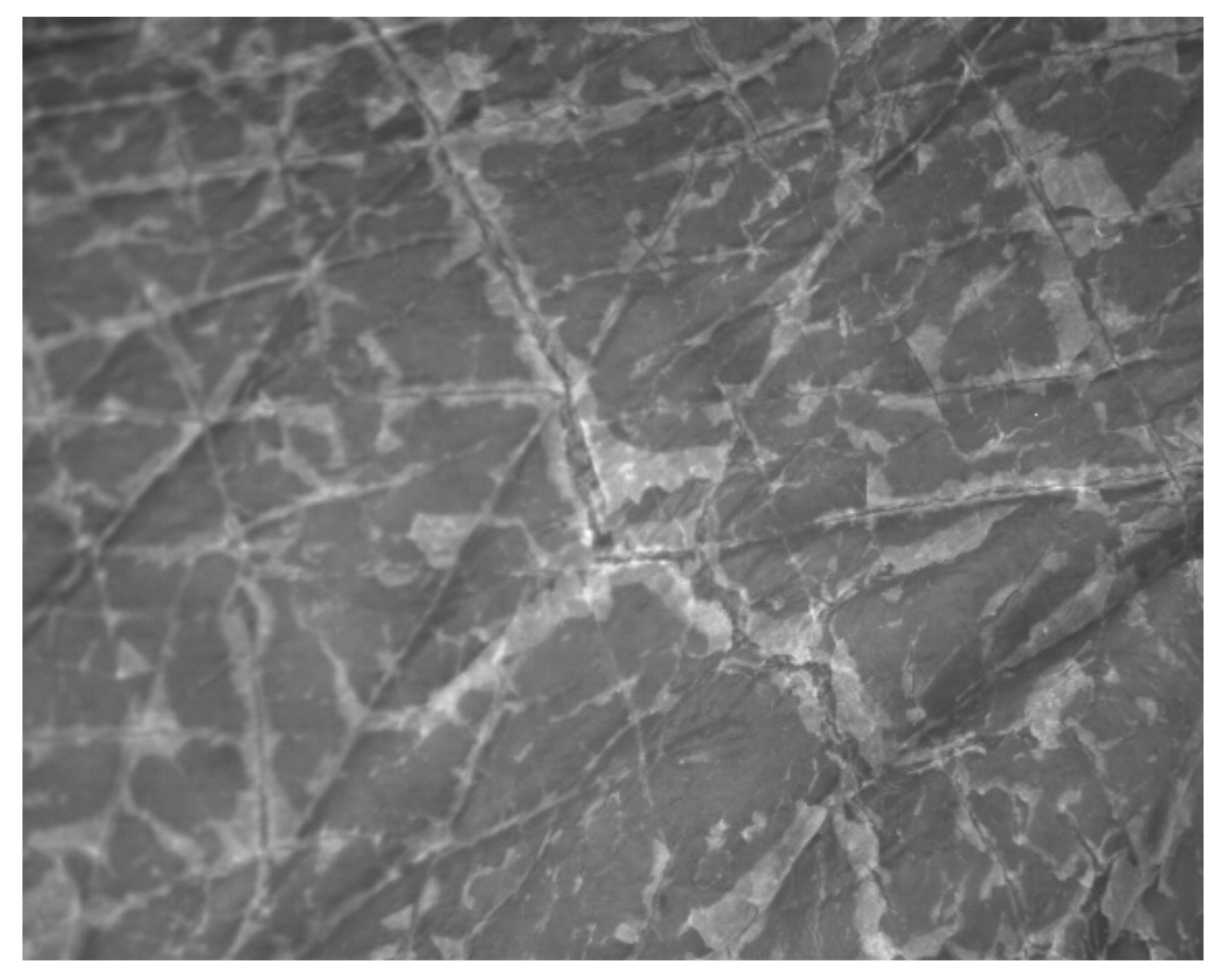

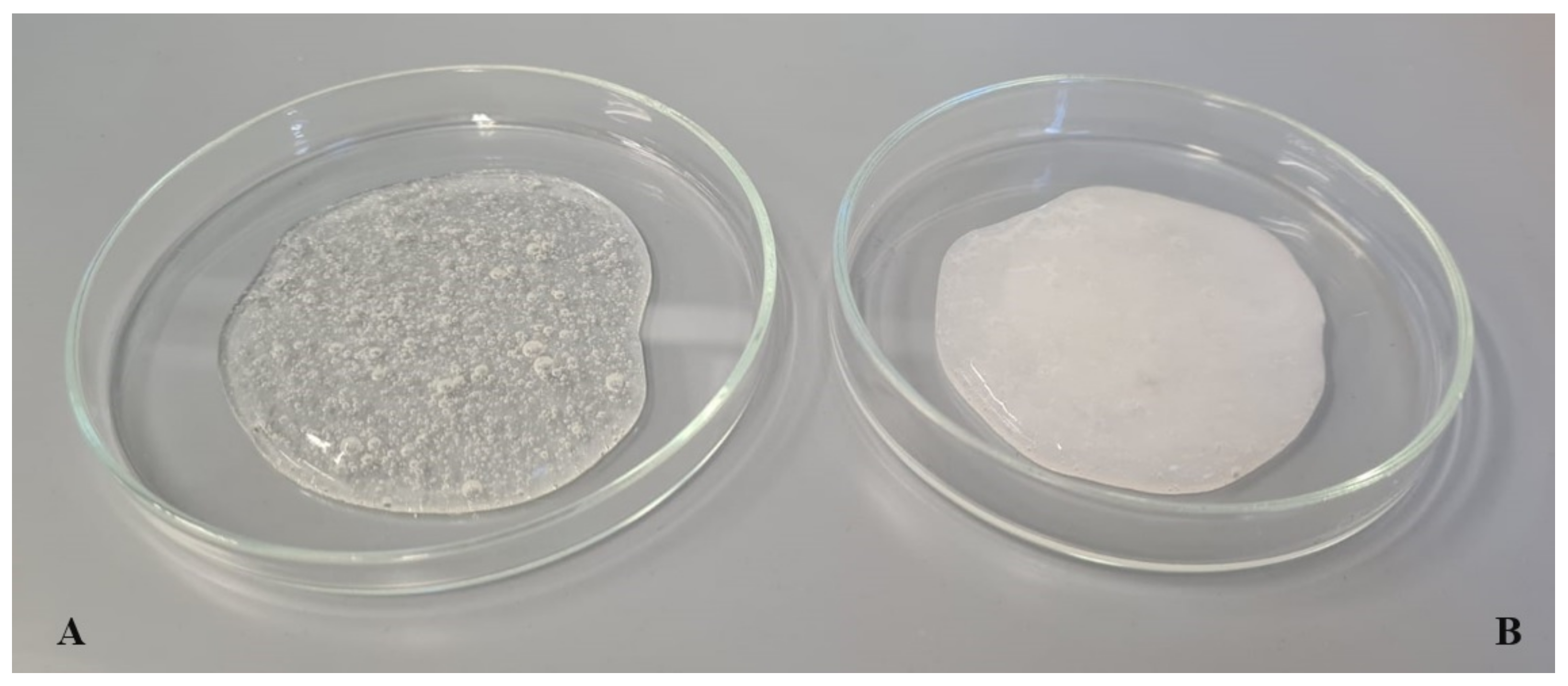
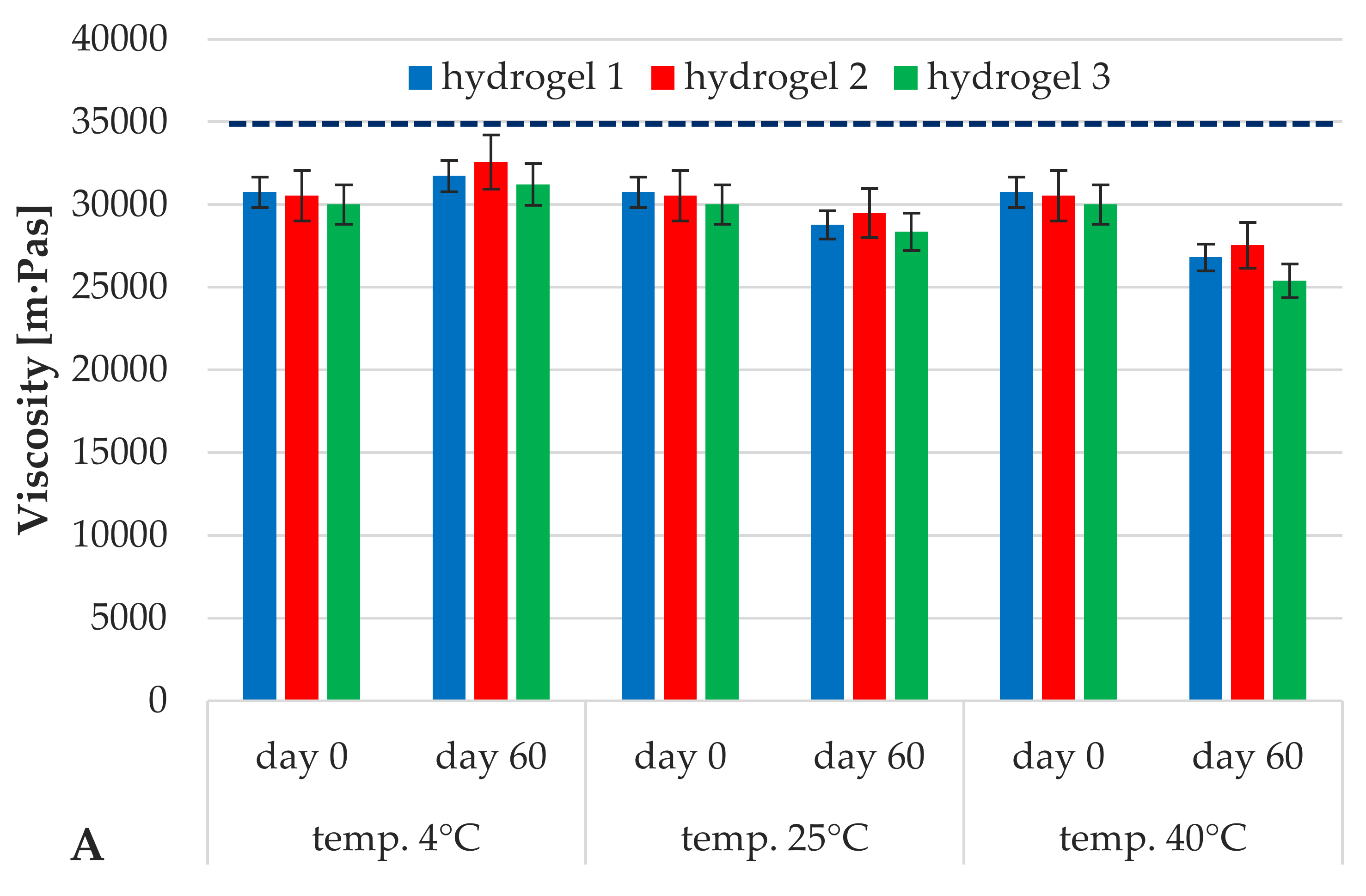
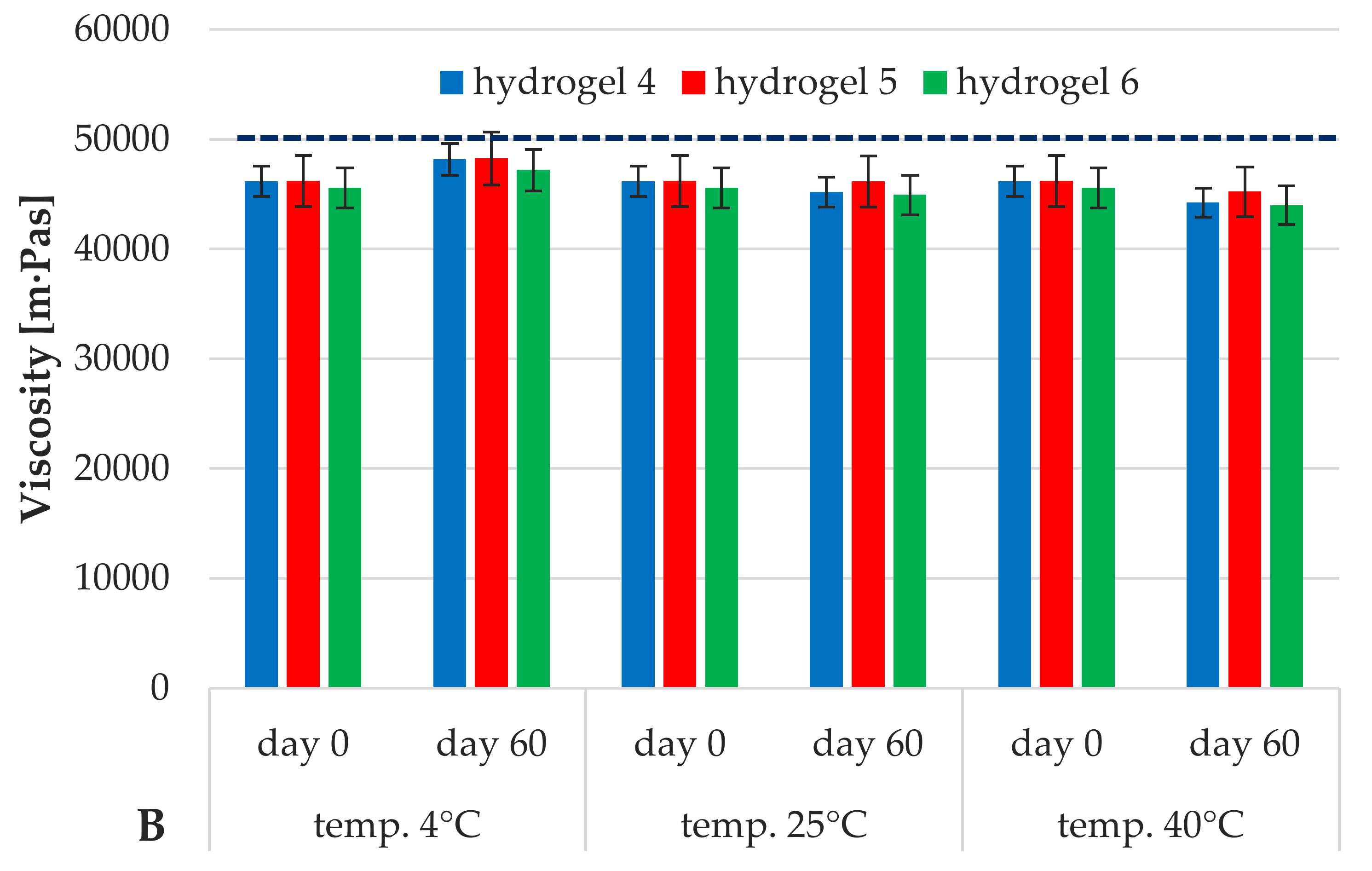
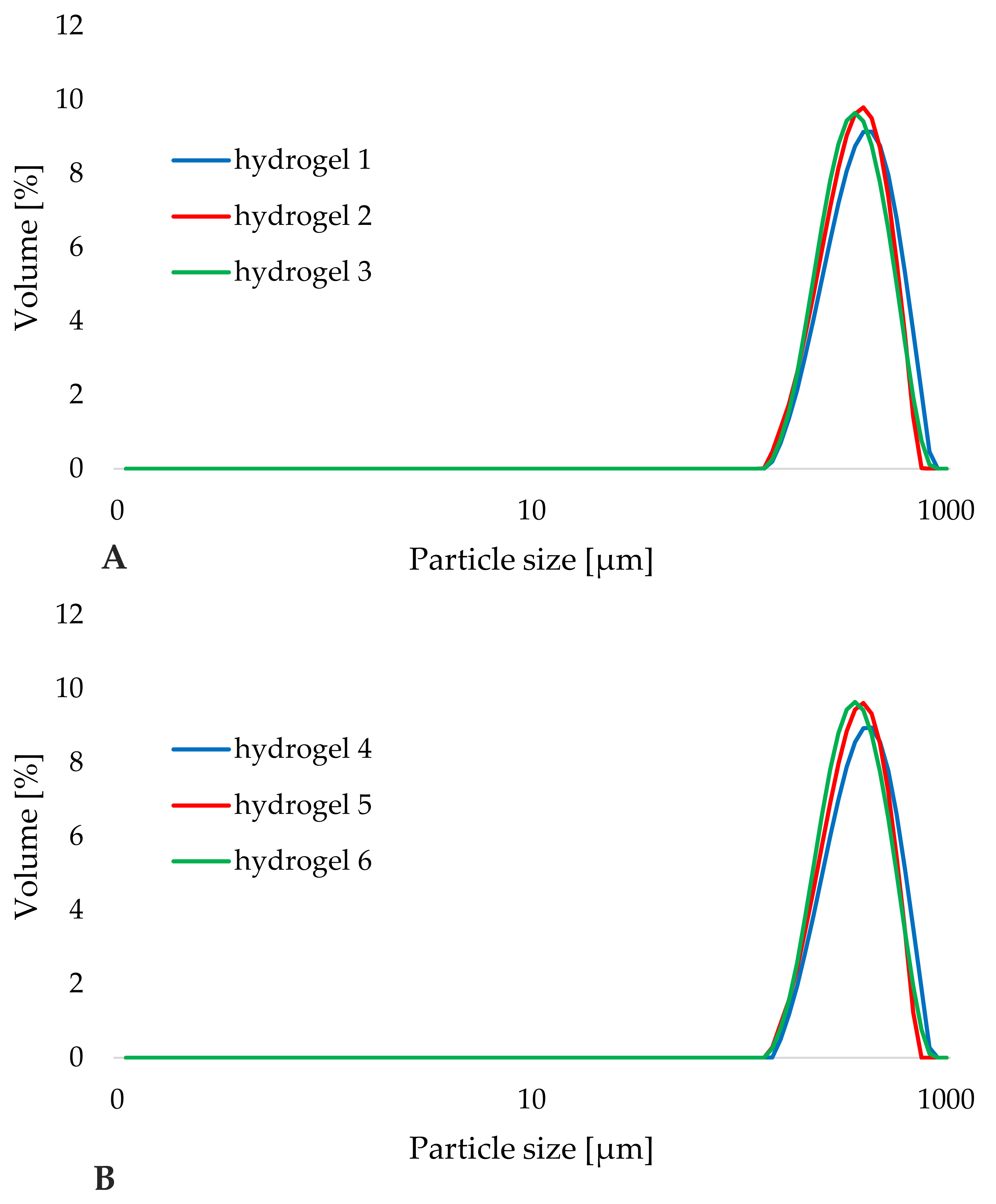
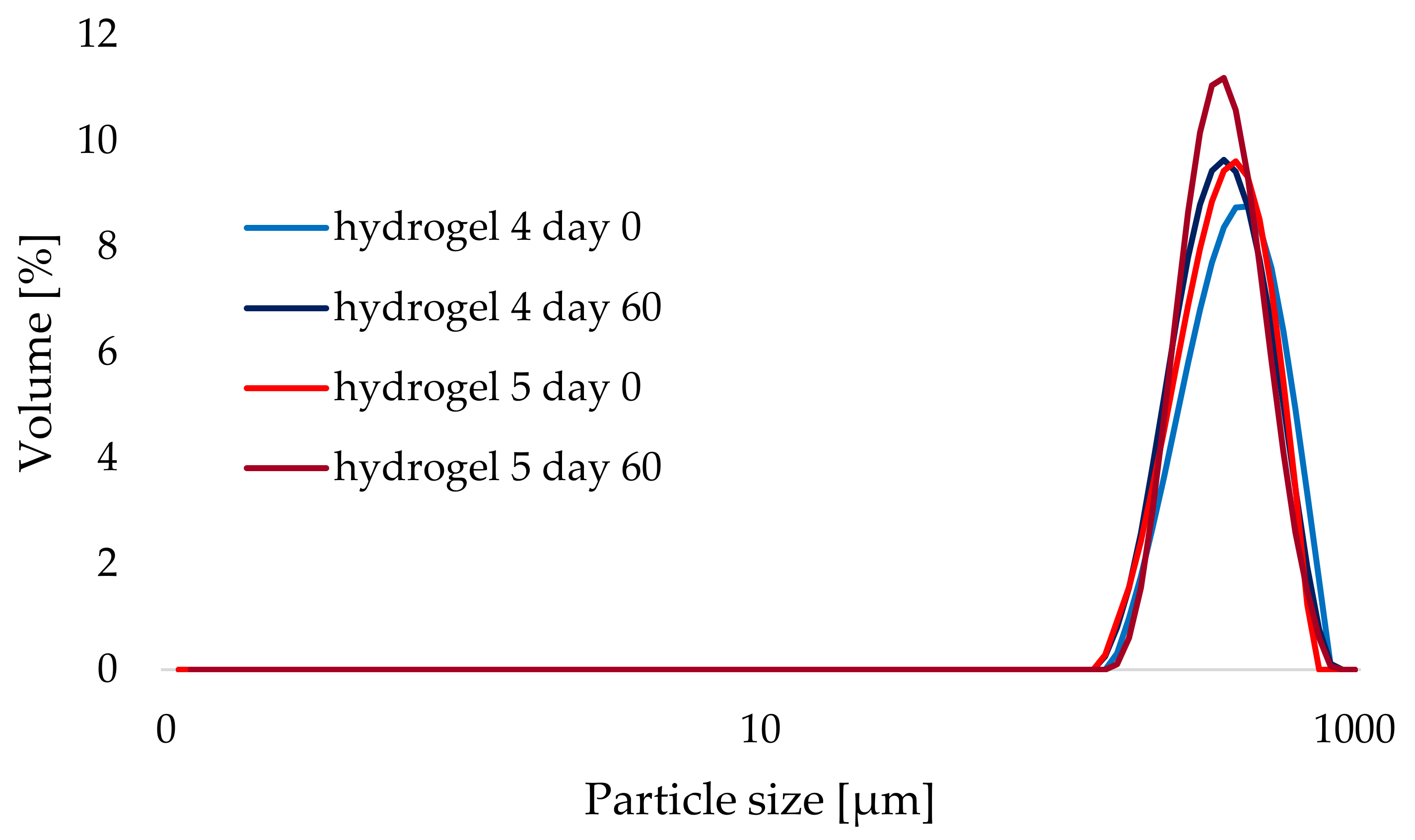

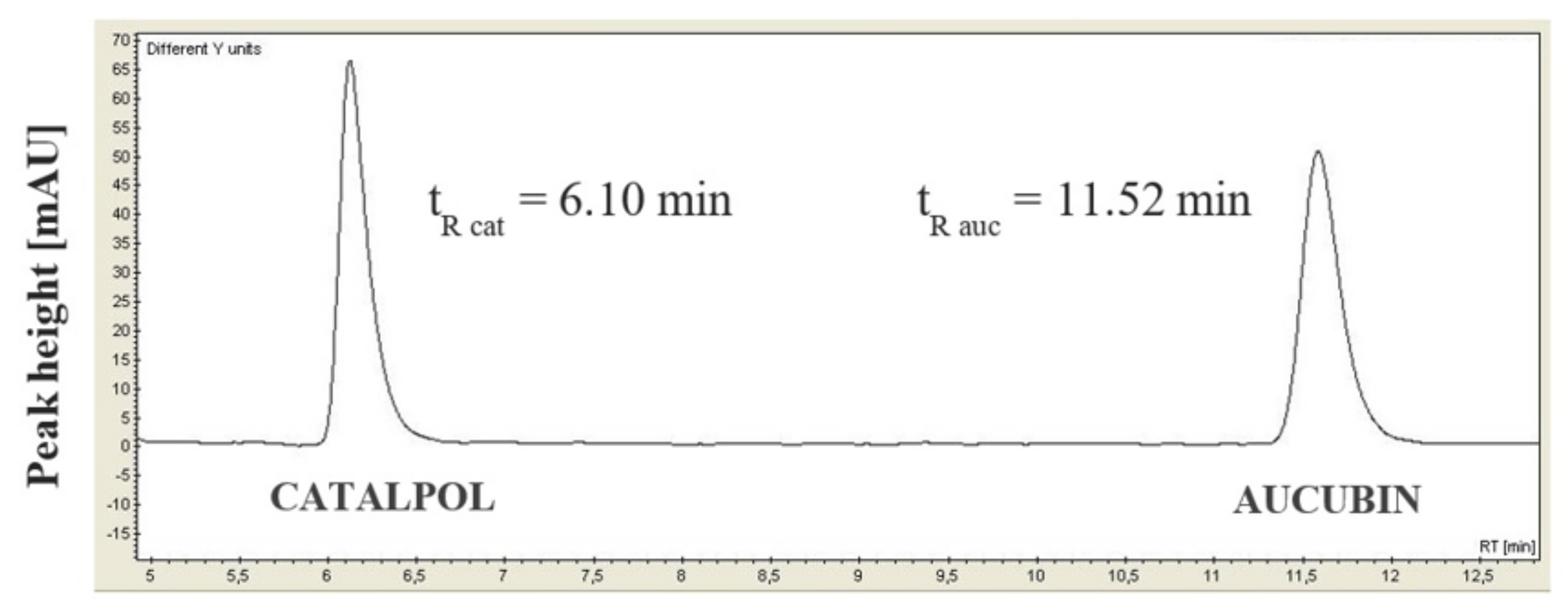
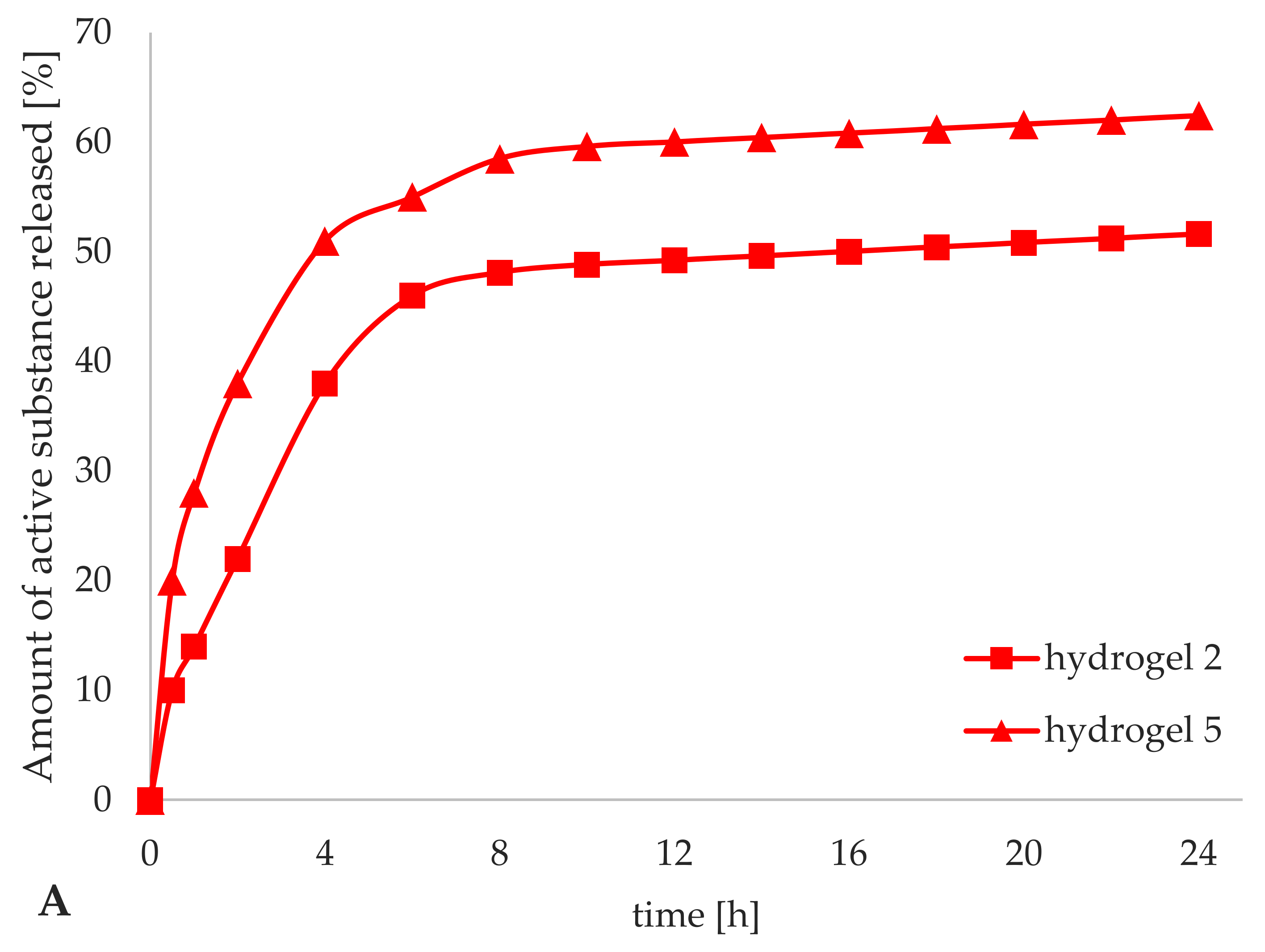
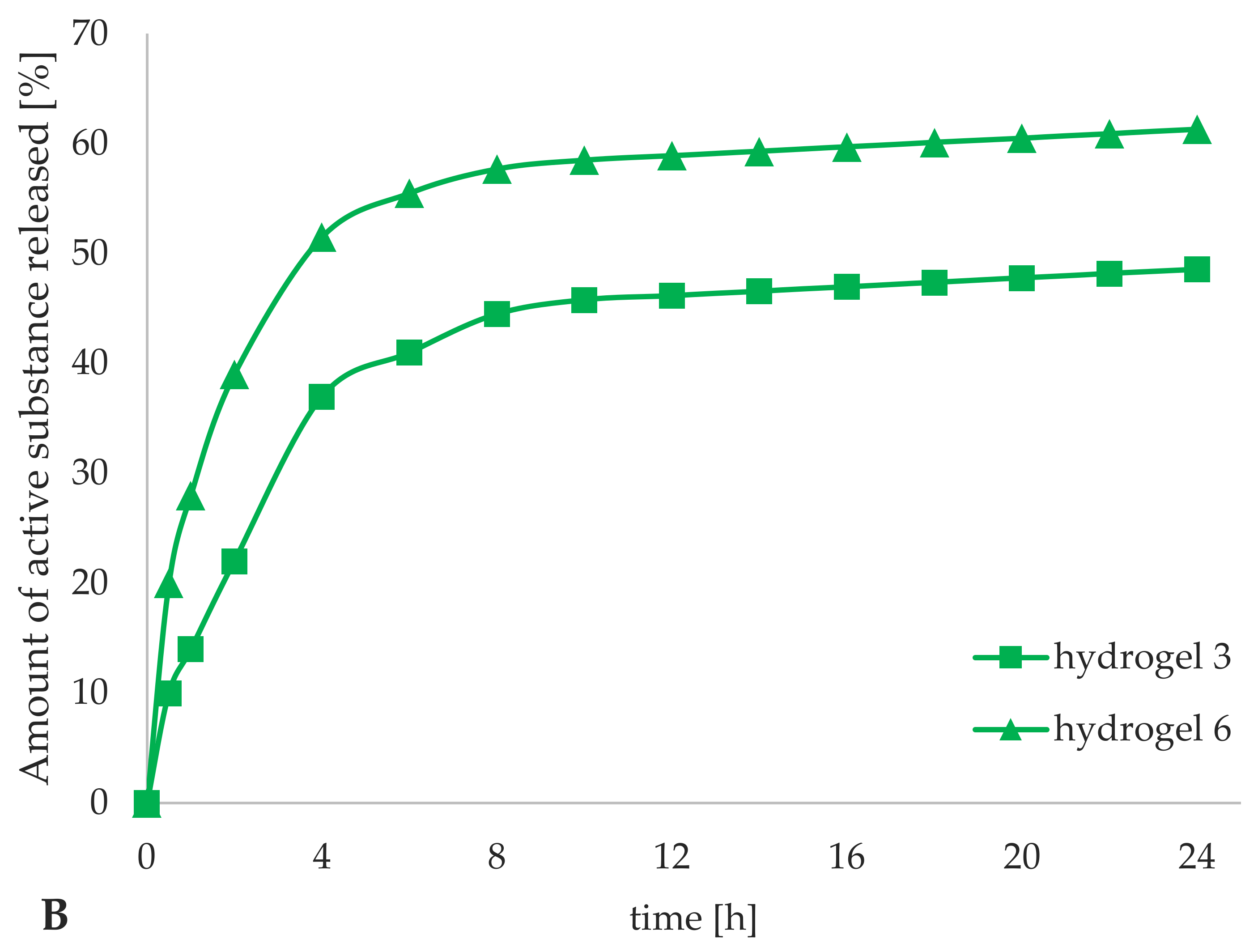
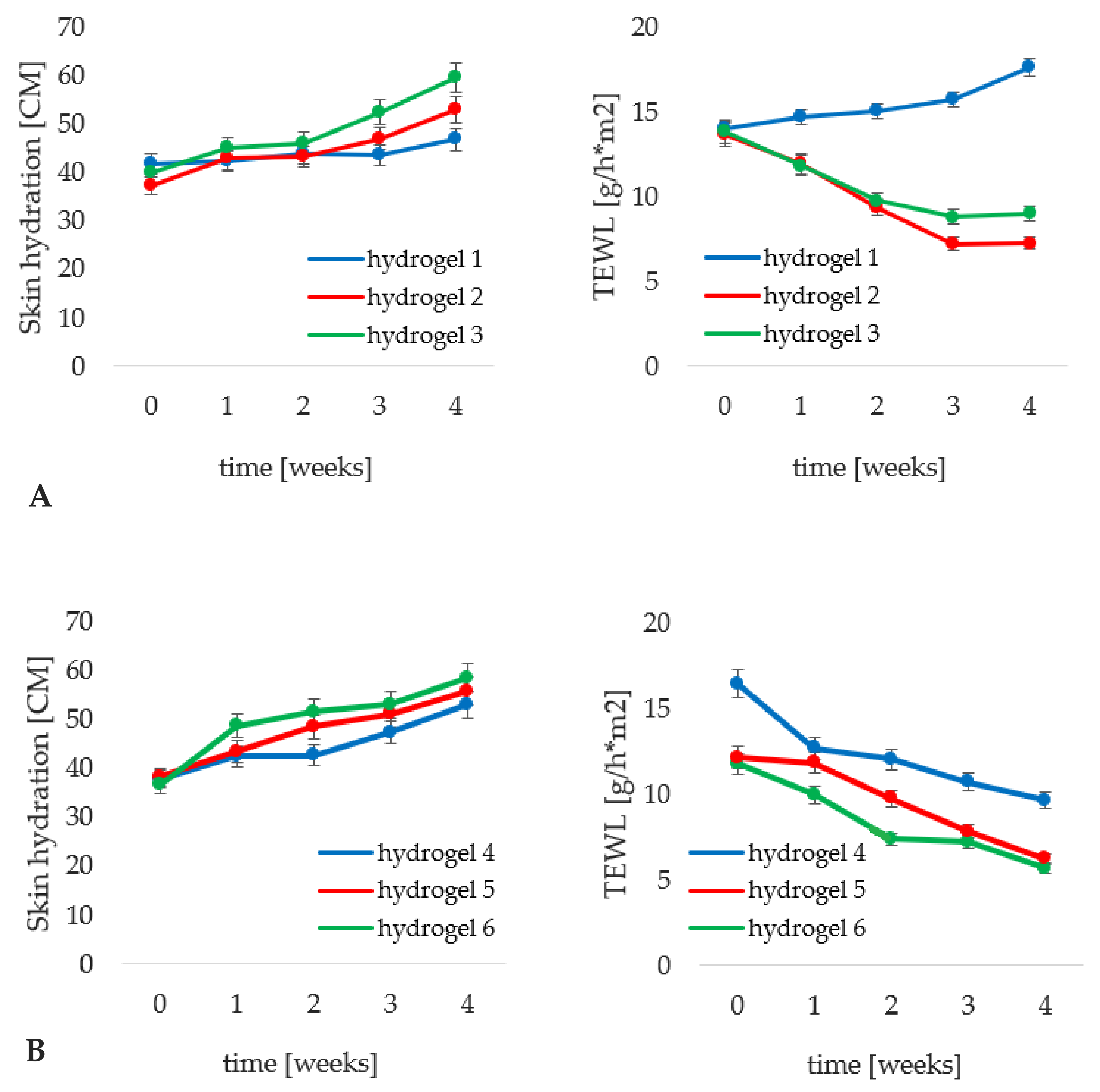

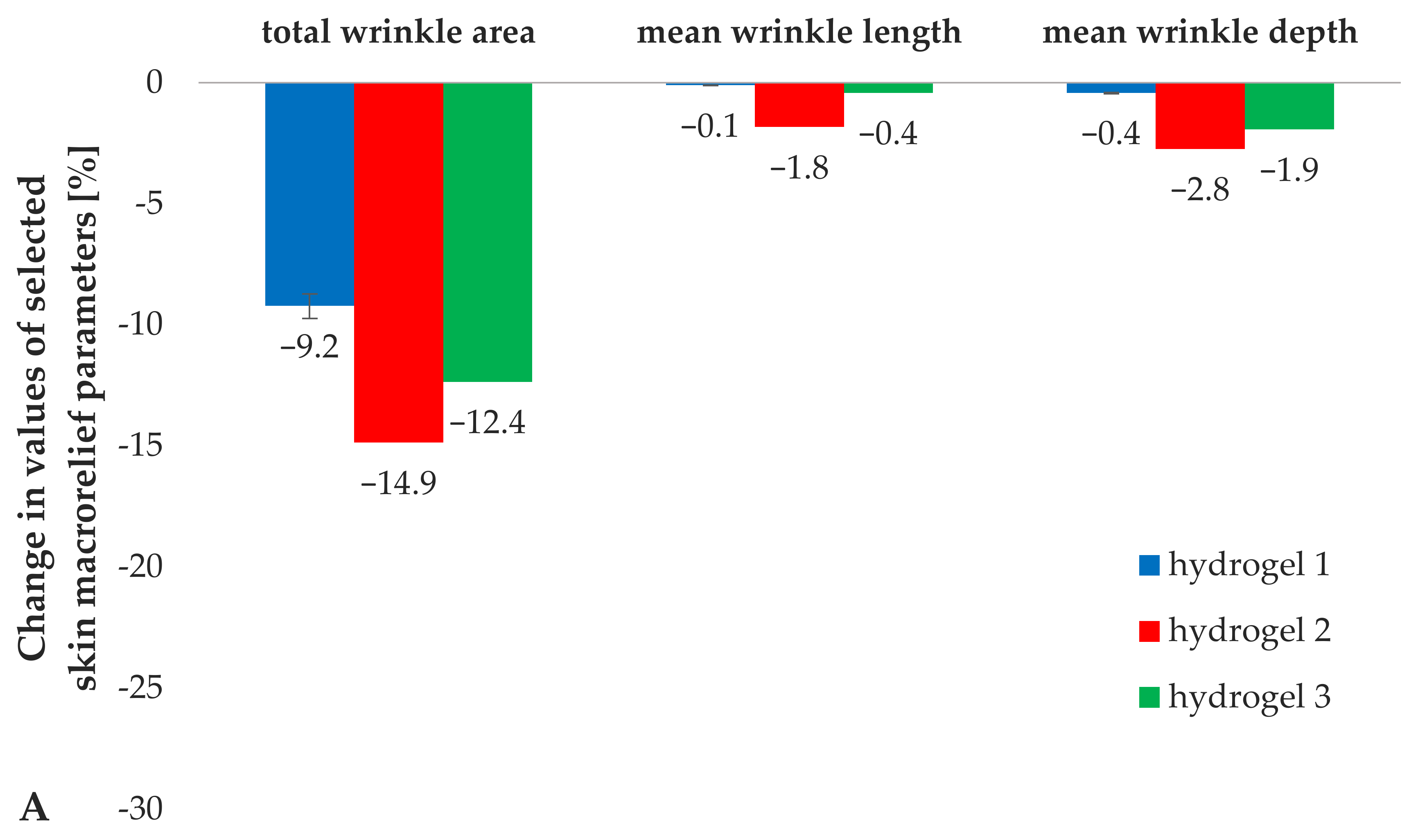
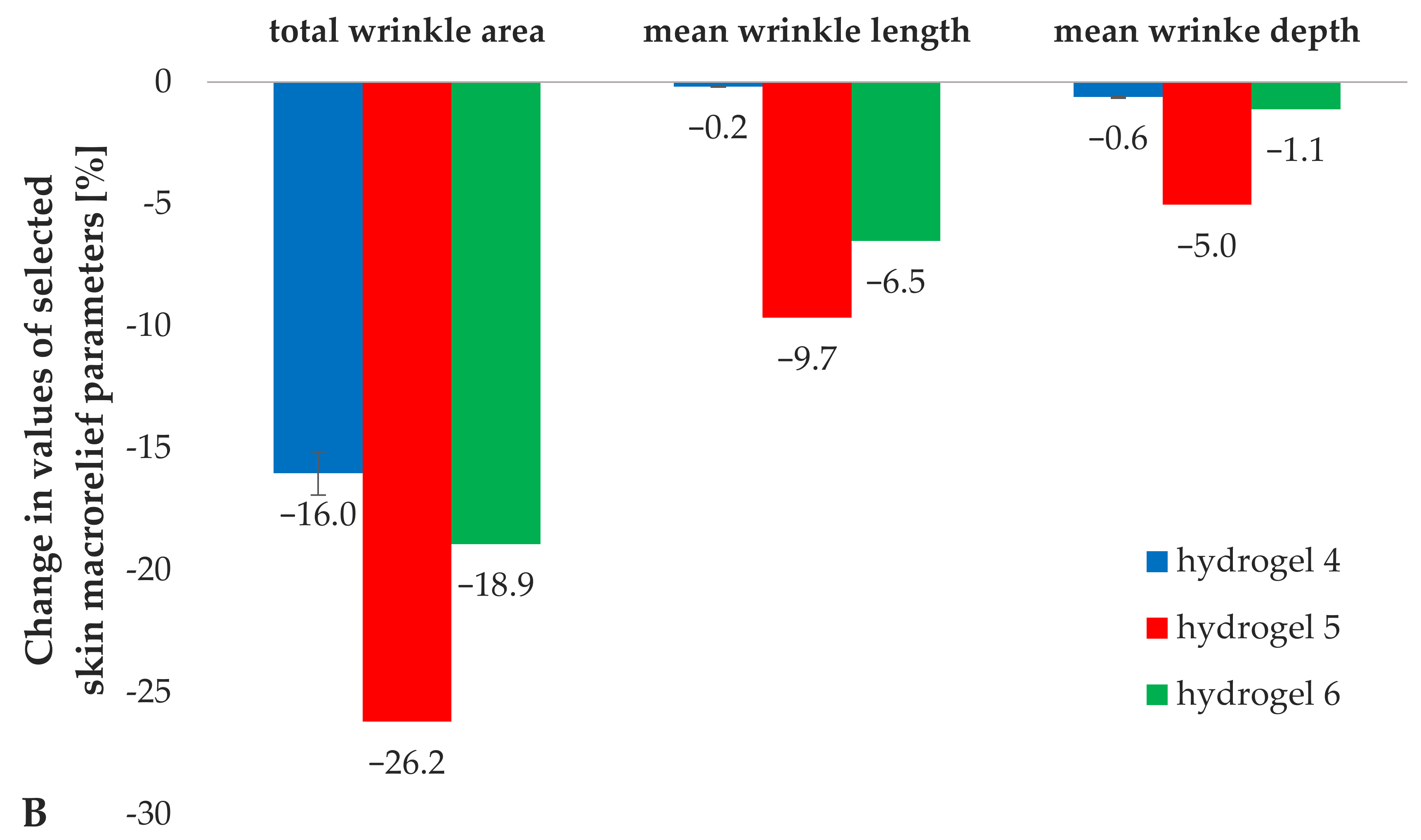
| HYDROGEL FORMULATION | INGREDIENT | QUANTITY [WT.%, ±0.01] |
|---|---|---|
| HYDROGEL 1 | Hydroxyethyl cellulose | 2.50 |
| Glycerol | 10.00 | |
| Microcare® SB 1 | 0.20 | |
| Demineralized water | 87.30 | |
| HYDROGEL 2 * HYDROGEL 3 ** | Hydroxyethyl cellulose | 2.50 |
| Glycerol | 10.00 | |
| Microcare® SB 1 | 0.20 | |
| Demineralized water | 86.80 | |
| Active substance (aucubin */catalpol **) | 0.50 | |
| HYDROGEL 4 *** HYDROGEL 5 **** HYDROGEL 6 ***** | Hydroxyethyl cellulose | 1.25 |
| Glycerol | 5.00 | |
| Microcare® SB 1 | 0.10 | |
| Demineralized water | 43.65 | |
| Lipid nanoparticle dispersion (without active ingredients ***/ with aucubin ****/catalpol *****) | 50.00 2 |
| STUDY NUMBER | COSMETIC NUMBER | CHARACTERISTIC OF HYDROGEL FORMULATION |
|---|---|---|
| 1 | HYDROGEL 1 | hydrogel without iridoid glycosides |
| HYDROGEL 2 | aucubin-containing hydrogel | |
| HYDROGEL 3 | catalpol-containing hydrogel | |
| 2 | HYDROGEL 4 | hydrogels enriched with lipid nanoparticles without iridoid glycosides |
| HYDROGEL 5 | hydrogels enriched with aucubin-loaded lipid nanoparticles | |
| HYDROGEL 6 | hydrogels enriched with catalpol-loaded lipid nanoparticles |
| pH [-, ±SD] | ||||||
|---|---|---|---|---|---|---|
| Temp. 4 °C | Temp. 25 °C | Temp. 40 °C | ||||
| Day 0 | Day 60 | Day 0 | Day 60 | Day 0 | Day 60 | |
| HYDROGEL 1 | 6.36 ± 0.02 | 6.40 ± 0.02 | 6.36 ± 0.02 | 6.40 ± 0.02 | 6.36 ± 0.02 | 6.36 ± 0.01 |
| HYDROGEL 2 | 6.26 ± 0.01 | 6.30 ± 0.01 | 6.26 ± 0.01 | 6.11 ± 0.02 | 6.26 ± 0.01 | 6.16 ± 0.01 |
| HYDROGEL 3 | 6.20 ± 0.01 | 6.03 ± 0.02 | 6.20 ± 0.01 | 6.06 ± 0.01 | 6.20 ± 0.01 | 6.17 ± 0.02 |
| HYDROGEL 4 | 6.26 ± 0.02 | 6.31 ± 0.01 | 6.26 ± 0.01 | 6.32 ± 0.02 | 6.26 ± 0.02 | 6.24 ± 0.01 |
| HYDROGEL 5 | 6.14 ± 0.01 | 6.18 ± 0.01 | 6.14 ± 0.01 | 6.12 ± 0.02 | 6.14 ± 0.01 | 6.11 ± 0.01 |
| HYDROGEL 6 | 6.12 ± 0.02 | 6.07 ± 0.02 | 6.12 ± 0.02 | 6.10 ± 0.01 | 6.12 ± 0.02 | 6.11 ± 0.03 |
| d(0.9) [μm, ±SD] | |||||
|---|---|---|---|---|---|
| Day 0 | Day 15 | Day 30 | Day 60 | ||
| HYDROGEL 1 | temp. 4 °C | 427.893 ± 4.340 | 424.623 ± 3.947 | 421.353 ± 5.096 | 418.083 ± 5.607 |
| temp.25 °C | 423.567 ± 4.198 | 420.040 ± 4.016 | 416.513 ± 4.954 | 412.986 ± 5.676 | |
| temp. 40 °C | 428.780 ± 4.302 | 422.252 ± 3.858 | 415.724 ± 5.058 | 409.196 ± 5.518 | |
| HYDROGEL 2 | temp. 4 °C | 416.926 ± 4.271 | 416.628 ± 3.844 | 416.330 ± 5.027 | 416.032 ± 5.504 |
| temp. 25 °C | 418.367 ± 4.138 | 418.015 ± 3.935 | 414.890 ± 4.894 | 411.765 ± 5.595 | |
| temp. 40 °C | 420.849 ± 4.328 | 415.566 ± 3.966 | 410.283 ± 5.084 | 405.000 ± 5.626 | |
| HYDROGEL 3 | temp. 4 °C | 423.492 ± 4.302 | 419.909 ± 3.820 | 416.326 ± 5.058 | 412.743 ± 5.480 |
| temp. 25 °C | 421.478 ± 4.138 | 418.351 ± 3.931 | 415.224 ± 4.894 | 412.097 ± 5.591 | |
| temp. 40 °C | 423.947 ± 4.239 | 418.575 ± 3.959 | 413.203 ± 4.995 | 407.831 ± 5.619 | |
| HYDROGEL 4 | temp. 4 °C | 428.009 ± 5.340 | 424.739 ± 5.947 | 421.469 ± 4.696 | 418.199 ± 6.607 |
| temp. 25 °C | 423.683 ± 5.198 | 420.156 ± 6.016 | 416.629 ± 4.554 | 413.102 ± 6.676 | |
| temp. 40 °C | 428.896 ± 5.302 | 422.368 ± 5.858 | 415.840 ± 4.658 | 409.312 ± 6.518 | |
| HYDROGEL 5 | temp. 4 °C | 417.042 ± 5.271 | 416.744 ± 5.844 | 416.446 ± 4.627 | 416.148 ± 6.504 |
| temp. 25 °C | 418.483 ± 5.138 | 418.131 ± 5.935 | 415.006 ± 4.494 | 411.881 ± 6.595 | |
| temp. 40 °C | 420.965 ± 5.328 | 415.682 ± 5.966 | 410.399 ± 4.684 | 405.116 ± 6.626 | |
| HYDROGEL 6 | temp. 4 °C | 423.608 ± 5.302 | 420.025 ± 5.820 | 416.442 ± 4.658 | 412.859 ± 6.480 |
| temp. 25 °C | 421.594 ± 5.138 | 418.467 ± 5.931 | 415.340 ± 4.494 | 412.213 ± 6.591 | |
| temp. 40 °C | 424.063 ± 5.239 | 418.691 ± 5.959 | 413.319 ± 4.595 | 407.947 ± 6.619 | |
| Temp. 4 °C | Temp. 25 °C | Temp. 40 °C | ||||
|---|---|---|---|---|---|---|
| Concentration [μg/mL, ±SD] | % * | Concentration [μg/mL, ±SD] | % * | Concentration [μg/mL, ±SD] | % * | |
| HYDROGEL 2 | 49.124 ± 0.131 | 1.75 | 48.971 ± 0.301 | 2.06 | 48.273 ± 0.423 | 3.45 |
| HYDROGEL 5 | 4.946 ± 0.376 | 1.09 | 4.933 ± 0.213 | 1.34 | 4.857 ± 0.156 | 2.86 |
| HYDROGEL 3 | 49.300 ± 0.225 | 1.40 | 48.998 ± 0.246 | 2.00 | 48.178 ± 0.238 | 3.64 |
| HYDROGEL 6 | 4.451 ± 0.317 | 1.03 | 4.440 ± 0.267 | 1.12 | 4.371 ± 0.254 | 2.78 |
Publisher’s Note: MDPI stays neutral with regard to jurisdictional claims in published maps and institutional affiliations. |
© 2021 by the authors. Licensee MDPI, Basel, Switzerland. This article is an open access article distributed under the terms and conditions of the Creative Commons Attribution (CC BY) license (https://creativecommons.org/licenses/by/4.0/).
Share and Cite
Dąbrowska, M.; Nowak, I. Lipid Nanoparticles Loaded with Selected Iridoid Glycosides as Effective Components of Hydrogel Formulations. Materials 2021, 14, 4090. https://doi.org/10.3390/ma14154090
Dąbrowska M, Nowak I. Lipid Nanoparticles Loaded with Selected Iridoid Glycosides as Effective Components of Hydrogel Formulations. Materials. 2021; 14(15):4090. https://doi.org/10.3390/ma14154090
Chicago/Turabian StyleDąbrowska, Marta, and Izabela Nowak. 2021. "Lipid Nanoparticles Loaded with Selected Iridoid Glycosides as Effective Components of Hydrogel Formulations" Materials 14, no. 15: 4090. https://doi.org/10.3390/ma14154090
APA StyleDąbrowska, M., & Nowak, I. (2021). Lipid Nanoparticles Loaded with Selected Iridoid Glycosides as Effective Components of Hydrogel Formulations. Materials, 14(15), 4090. https://doi.org/10.3390/ma14154090






